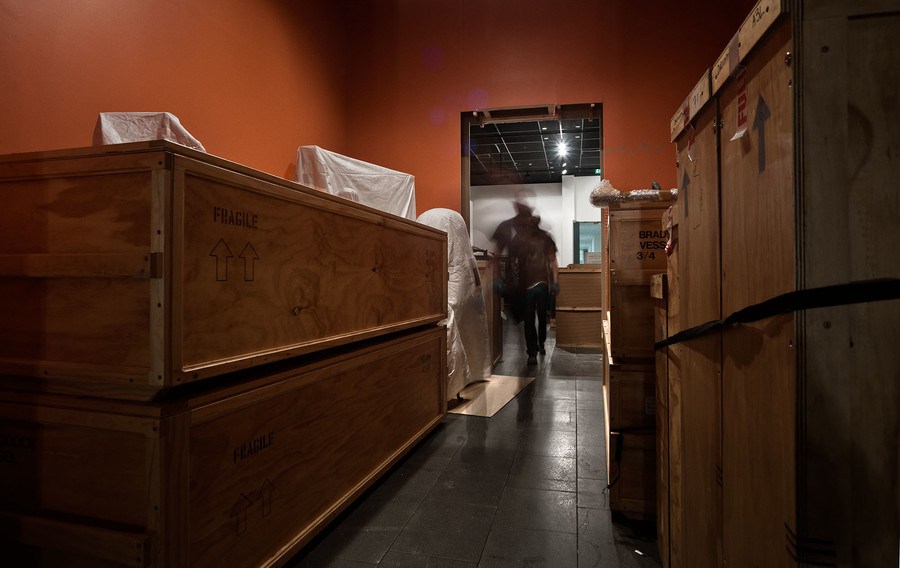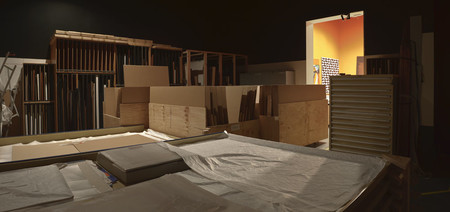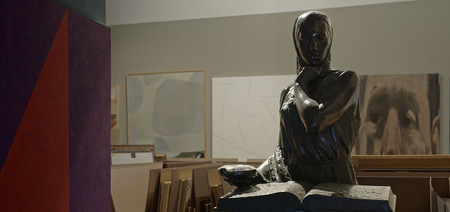A Warehouse in a Tutu

Christchurch Art Gallery was described—upon opening to the public in 2003—as ‘a warehouse in a tutu’. The glass façade on the front of the building remained an uncrossable barrier, but the internal skeleton had finally lived up to its warehouse capabilities.
APRIL 2011, AND THE GALLERY was occupied by CERA, Civil Defence, the City Council and a host of other city officials tasked with the immense job of tackling the destruction that had crippled our city. We’d been occupied since 22 February, and although our immediate future was uncertain, having been through this already in September 2010 (just before staging the hugely successful Ron Mueck exhibition) most staff remained positive that we’d be able to resume normal transmission sooner rather than later. So, despite awaiting internal post-quake repairs to my home, I decided to push on and take a few weeks to sand and paint my house—an old weatherboard bungalow in New Brighton that had taken decades of battering from the predominant north-easterly wind. It was hardly dilapidated, but a spruce-up was overdue. After four days on the end of an orbital sander, two days on a ladder painting the eaves and bargeboards, a week of double coating the weatherboards and another week of sills, foundations and trims I had run out of time. And I still had to get a couple of coats of enamel on the multi-pane windows—an immense amount of brushwork that was going to keep me busy for a few weekends to come. When I got back to work, however, nothing much had changed for the better in my absence. In fact, if anything, the picture was a little murkier regarding the Gallery’s reopening, and the tall apartment buildings next door were beginning to emerge as something of an elephant in the room we all now shared. Nobody really wanted to address them; they were spoken of only in hushed tones, as if silence would make the increasingly evident problem go away. We continued to make plans for new shows even as the mutterings grew in volume, and the ramifications of a potential demolition next door began to circulate. And then suddenly project managers and insurers were involved and our worst fears began to become reality. The whole collection would have to be moved.
Landscapes sat beside abstracts, portraits hung above reliefs, waterfalls mixed with farmyard animals and distinguished scholars shared wall space with spot-lit eighties pop stars.

It was a hugely daunting task, but much like painting a house, it was all about the preparation. In that sense, there was a genuinely collaborative effort between the curatorial, exhibitions, conservation and registration teams. But with so many unknowns to deal with (When would we get our building back? When would demolition start? Would the earth stay still?) at first our discussions seemed to begin at no fixed point and have no end; they overlapped, contradicted and circled back upon themselves. However, slowly a plan emerged—at some point you have to put down the sander and pick up the paintbrush.
A swathe of stores throughout the building housing sculpture, textiles, works on paper, contemporary and historic paintings, small objects and a multitude of miscellaneous artworks were to be corralled into one location in our downstairs exhibition galleries. We had a looming deadline—only slightly less ominous than the leaning towers that necessitated the shift in the first place. Both the stores and the site of their proposed relocation were measured, and though we were confident that everything would fit there was no doubt that it was going to be tight. But it was complicated—much like the display of artworks, the safe storage of those items means that they all have their own individual needs. And so it began…
It was decided that a vast number of paintings, drawings and photographs would be housed in temporary plywood bins, the artworks interleaved with sheets of cardboard. Over seventy bins had to be built, each one with a base of 120 x 174cm, two short sides and two tall ends. They had wooden block feet attached and each was able to house a large number of artworks, dependent on weight, size and depth. The great thing about the bins was that they could be wheeled into the stores on dollies, filled with artworks, wheeled out again to their new home and then lowered onto the floor with a pallet jack. Their mobility allowed us to store them in a tetris-like manner, creating paths through the maze where needed. It also meant no double-handling. Each artwork was removed from its storage rack or shelving unit by technicians, its accession number read out loud to the registrar, who gave it a new bin location on an endless scroll of lists that ensured every artwork had an accurately recorded location at all times. The bins all had an elaborate coding system that was fed into a master floorplan that could be referred to should an artwork need to be found.
While this was happening, the shelving units housing the many large crates of sculpture that the Gallery owns had their contents removed, were entirely dismantled in the stores and reassembled downstairs, with the crates put back in place exactly as they had been. This was heavy, difficult work, but tackled early in the shift to gain some momentum while others were in the workshop building the plywood bins. Indeed, the bin building was a weeks-long exercise that involved a constant stream of timber deliveries; the wood diced up on the table saw in a production-line fashion, assembled in batches of four with a pin gun, screws, and glue and then lined with strips of foam to protect the frames and edges of artworks. The first few were kind of rewarding, but the job became tedious no matter how many philosophical discussions were had, how many bad jokes were told, or how loud Classic hits was pumped on the workshop stereo.
It was hard to imagine this as the scene of a giant Civil Defence rescue operation (as it had recently been), or indeed even as a space for displaying art, despite the fact that there were thousands of artworks everywhere you looked.

Ernest George Gillick Ex Tenebris Lux (detail) 1937. Bronze. Collection of Christchurch Art Gallery Te Puna o Waiwetu, presented by R.E. McDougall. Reproduced courtesy of Norah B. Landells
At this stage the Brought To Light collection exhibition was still largely on the walls, and this had to be packed down for storage as well. The works on paper store—a series of rolling shelves filled with hundreds of Solander boxes, themselves filled with thousands of matted drawings, prints,
photographs and watercolours—was rolled down on laden trolleys and stacked in a small gallery space previously home to a series of books created by Leo Bensemann at Caxton Press. Like De-Building and Van der Velden: Otira, the Leo Bensemann show was certainly not forgotten—the wall colours, labels and didactics still adorned the walls and were quickly becoming a backdrop to an insane new ‘exhibition’ that was taking on a life of its own.
The eccentricities of the new display became especially apparent as larger and more fragile works were hung on the Gallery walls in a mad salon-style hang, unprecedented in scale and scope. Works that had entered the collection decades ago and largely wallowed in the depths of storage ever since were suddenly thrust into the limelight, given centre stage in what was beginning to look more and more like a bizarre experiment—one with no curatorial rationale but dictated instead by that fact that ‘this work will fit in that space’. Landscapes sat beside abstracts, portraits hung above reliefs, waterfalls mixed with farmyard animals and distinguished scholars shared wall space with spot-lit eighties pop stars.
Giant steel units were systematically emptied of their contents; the drawers tipped sideways onto trolleys, angled carefully—and barely!—into our goods lift, and refilled with their precious cargo on the ground floor. Slot racks were assembled out of timber framing in-situ—grids built from four-by-two with little more than a ladder and a nail-gun. These were loaded with seascapes and mountain views, the curly bits on their gilded frames protected by sponges and ether foam, paintings stored back-to-back with the greatest of care. Textile rolls were pushed into corners, recent acquisitions not even accessioned yet were grouped together, and hundreds of orange crates full of archives were brought down from the library by way of the fumigation room.
Weeks of planning melded into weeks of shifting, as nooks and crannies filled with all of the anomalous objects that would fit nowhere else. It became hard to imagine this as the scene of a giant Civil Defence rescue operation (as it had recently been), or indeed even as a space for displaying art, despite the fact that there were thousands of artworks everywhere you looked.
Christchurch Art Gallery was described—upon opening to the public in 2003—as ‘a warehouse in a tutu’.1 The glass façade on the front of the building remained an uncrossable barrier, but the internal skeleton had finally lived up to its warehouse capabilities. With stacks of crates, bins, tables, and shelves lining the touring gallery spaces, the master floorplan was finally adjusted and the details sent to the insurers. And then the lights were turned out and the spaces put into lockdown.
Months have since passed and the demolition of the next-door apartments has now been completed. I’ve finished painting all of the windows at home, indeed some of the internal repair work has even been carried out, and I’ve become a father to a beautiful wee girl. We’ve put aside the prospect of reopening for the moment and instead launched into a variety of exciting off-site projects, from huge murals to haunted houses to temporary exhibitions in places we wouldn’t have imagined using this time a year ago. But I can hear some familiar footsteps approaching; there’s another elephant on the way, and it is likely to take up residence in our temporary offices in a small corner of our largely inaccessible building. For just as surely as the north-easterly will keep on blowing, and as surely as my house will need to be repainted in the years to come, before we can reinstate a dynamic suite of exhibitions and finally open again to our sorely missed public, we’re going to have to move the entire collection back again...
Chris Pole
Exhibitions designer







